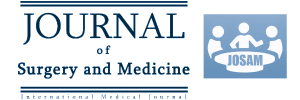Submissions
Submission Preparation Checklist
As part of the submission process, authors are required to check off their submission's compliance with all of the following items, and submissions may be returned to authors that do not adhere to these guidelines.- The submission has not been previously published, nor is it before another journal for consideration (or an explanation has been provided in Comments to the Editor).
- The submission file is in Microsoft Word document file format.
-
The text is double-spaced; uses a 12-point font; and all illustrations, figures, and tables with legends are placed within the text at the end.
- The text adheres to the stylistic and bibliographic requirements outlined in the Author Guidelines.
- All manuscripts should be submitted with good English and clear phrasing for the benefit of editors and reviewers.
- Journal of Surgery and Medicine (JOSAM) imposes high English language and scientific medical writing standards. JOSAM editors strongly encourage contributors whose English is not excellent to have their manuscripts edited by a professional translator or native English speaker before submission. For manuscripts with less than optimal English language, authors must provide the corrected manuscript and a certificate of professional language editing. Otherwise, authors may choose to arrange the paid JOSAM language editing service provided by American Manuscript Editors.
Copyright Notice
The copyright for the article published in a journal by JOSAM is retained by the author(s). Author/s grant/s the publisher a license to publish the article and identify itself as the original publisher. Even after the paper is published, the copyright is retained by the author(s).
If the article contains any material protected by the copyright of others, the author/s will deliver written permission from the copyright owner to reproduce such material in the article to “Journal of Surgery and Medicine (JOSAM)”.
The author/s represent/s and warrant/s that he/she/they is/are the author/s and proprietor/s of the article, that he/she/they has/have not granted or assigned any rights in the article to any other person or entity, that the article is copyrightable, that it does not infringe upon any copyright, trademark, or patent, that it does not invade the right of privacy or publicity of any person or entity, that it does not contain any libelous matter, that all statements asserted as facts are true or based upon reasonable research for accuracy and that, to the best of the author’s knowledge, no formula, procedure, or prescription contained in the article would cause injury if used or followed in accordance with the instructions and/or warnings contained in the article.
Roles and Responsibility of Author/s
All individuals listed as authors should fulfill at least one criteria from each category: -Experiment Design and Data Collection (conception and design, acquisition of data, interpretation of data) -Manuscript Creation (participated in drafting the article, revised it critically for important intellectual content -Manuscript Revision (have given final approval of the revision to be submitted and any revised version to be published).
Each author should have participated sufficiently in the work to take public responsibility for appropriate portions of the content. Allowing one’s name to appear as an author without having contributed significantly to the study or adding the name of an individual who has not contributed or who has not agreed to the work in its current form is considered a breach of appropriate authorship.
Acquisition of funding, collection of data, contributing cases, or general supervision of the research group, of itself, or just being the chair of the department does not justify authorship if the above criteria are not fulfilled. As an author of this article, I/we certify that none of the material in the manuscript has been previously published, is included in another manuscript, or is currently under consideration for publication elsewhere. I also certify that this article has not been accepted for publication elsewhere, nor have I assigned any right or interest in the manuscript to any third party. Moreover, should the editor of the Journal of Surgery and Medicine (JOSAM) request the data upon which the manuscript is based, I/we shall produce it.
Conflict of Interest / Financial Disclosure
I, the undersigned author, certify that I/we have no commercial associations (e.g., consultancies, stock ownership, equity interests, patent-licensing arrangements, etc.) that might pose a conflict of interest in connection with the submitted article, except as disclosed on a separate attachment. All funding sources supporting the work and all institutional or corporate affiliations of mine are acknowledged in a footnote.
Plagiarism Statement
I certify that this assignment/report is my own work, based on my personal study and/or research and that I have acknowledged all material and sources used in its preparation, whether they be books, articles, reports, lecture notes, and any other kind of document, electronic or personal communication. I also certify that this assignment/report has not previously been submitted for assessment in any other unit, except where specific permission has been granted from all unit coordinators involved, or at any other time in this unit, and that I have not copied in part or whole or otherwise plagiarized the work of other students and/or persons.
Please download and sign the Authors' Agreement Form , and then upload it along with the manuscript files.
Quick templates
Title-Page docx file
Research-Article docx file
Review docx file
Case-Report docx file
Privacy Statement
The names and email addresses entered in this journal site will be used exclusively for the stated purposes of this journal and will not be made available for any other purpose or to any other party.








